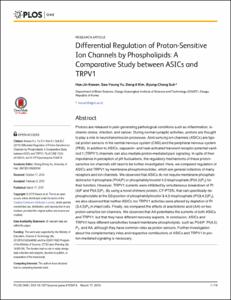Full metadata record
| DC Field | Value | Language |
|---|---|---|
| dc.contributor.author | Kweon, Hae Jin | - |
| dc.contributor.author | Yu, Soo Young | - |
| dc.contributor.author | Kim, Dong Il | - |
| dc.contributor.author | Suh, Byung Chang | - |
| dc.date.available | 2017-05-11T01:36:54Z | - |
| dc.date.created | 2017-04-10 | - |
| dc.date.issued | 2015-03 | - |
| dc.identifier.issn | 1932-6203 | - |
| dc.identifier.uri | http://hdl.handle.net/20.500.11750/1575 | - |
| dc.description.abstract | Protons are released in pain-generating pathological conditions such as inflammation, ischemic stroke, infection, and cancer. During normal synaptic activities, protons are thought to play a role in neurotransmission processes. Acid-sensing ion channels (ASICs) are typical proton sensors in the central nervous system (CNS) and the peripheral nervous system (PNS). In addition to ASICs, capsaicin- and heat-activated transient receptor potential vanilloid 1 (TRPV1) channels can also mediate proton-mediated pain signaling. In spite of their importance in perception of pH fluctuations, the regulatory mechanisms of these proton-sensitive ion channels still need to be further investigated. Here, we compared regulation of ASICs and TRPV1 by membrane phosphoinositides, which are general cofactors of many receptors and ion channels. We observed that ASICs do not require membrane phosphatidylinositol 4-phosphate (PI(4)P) or phosphatidylinositol 4,5-bisphosphate (PI(4,5) P2) for their function. However, TRPV1 currents were inhibited by simultaneous breakdown of PI (4)P and PI(4,5)P2. By using a novel chimeric protein, CF-PTEN, that can specifically dephosphorylate at the D3 position of phosphatidylinositol 3,4,5-trisphosphate (PI(3,4,5)P3), we also observed that neither ASICs nor TRPV1 activities were altered by depletion of PI (3,4,5)P3 in intact cells. Finally, we compared the effects of arachidonic acid (AA) on two proton-sensitive ion channels. We observed that AA potentiates the currents of both ASICs and TRPV1, but that they have different recovery aspects. In conclusion, ASICs and TRPV1 have different sensitivities toward membrane phospholipids, such as PI(4)P, PI(4,5) P2, and AA, although they have common roles as proton sensors. Further investigation about the complementary roles and respective contributions of ASICs and TRPV1 in proton-mediated signaling is necessary. © 2015 Kweon et al. | - |
| dc.language | English | - |
| dc.publisher | Public Library of Science | - |
| dc.title | Differential Regulation of Proton-Sensitive Ion Channels by Phospholipids: A Comparative Study between ASICs and TRPV1 | - |
| dc.type | Article | - |
| dc.identifier.doi | 10.1371/journal.pone.0122014 | - |
| dc.identifier.scopusid | 2-s2.0-84924942751 | - |
| dc.identifier.bibliographicCitation | PLoS ONE, v.10, no.3 | - |
| dc.description.isOpenAccess | TRUE | - |
| dc.subject.keywordPlus | EPITHELIAL NA+ CHANNEL | - |
| dc.subject.keywordPlus | TUMOR-SUPPRESSOR PTEN | - |
| dc.subject.keywordPlus | PHOSPHATIDYLINOSITOL 4,5-BISPHOSPHATE | - |
| dc.subject.keywordPlus | CAPSAICIN RECEPTOR | - |
| dc.subject.keywordPlus | PLASMA-MEMBRANE | - |
| dc.subject.keywordPlus | NOCICEPTIVE NEURONS | - |
| dc.subject.keywordPlus | ARACHIDONIC-ACID | - |
| dc.subject.keywordPlus | SENSORY NEURONS | - |
| dc.subject.keywordPlus | LOW PH | - |
| dc.subject.keywordPlus | PHOSPHOINOSITIDES | - |
| dc.citation.number | 3 | - |
| dc.citation.title | PLoS ONE | - |
| dc.citation.volume | 10 | - |
- Files in This Item:
-

10.1371_journal.pone.0122014.pdf
기타 데이터 / 4.7 MB / Adobe PDF download
- Appears in Collections:
- Department of Brain Sciences Laboratory of Brain Signal and Synapse Research 1. Journal Articles



